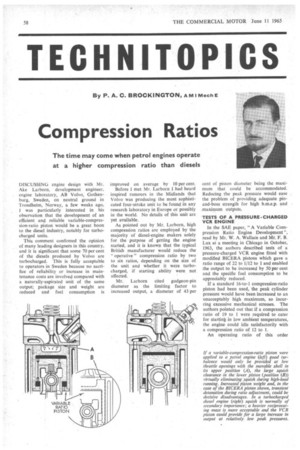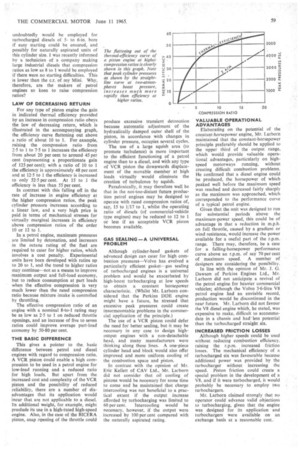TECHNITOPICS
Page 60

Page 61

If you've noticed an error in this article please click here to report it so we can fix it.
By P. A. C. BROCKINGTON, AMIMechE
Compression Ratios
The time may come when petrol engines operate at a higher compression ratio than diesels
DISCUSSING engine design with Mr. Ake Larborn, development engineer, engine laboratory, AB Volvo, Gothenburg, Sweden, on neutral ground in Trondheim, Norway, a few weeks ago, I was particularly interested in his observation that the development of an efficient and reliable variable-compression-ratio piston would be a great boon to the diesel industry, notably for turbocharged units.
This comment confirmed the opinion of many leading designers in this country, and it is significant that some 70 per cent of the diesels produced by Volvo are turbocharged. This is fully acceptable to operators in Sweden because no sacrifice of reliability or increase in maintenance costs are involved compared with a naturally-aspirated unit of the same output; package size and weight are reduced and fuel consumption is improved on average by 10 per cent.
Before I met Mr. Larborn I had heard inspired rumours in the Midlands that Volvo was producing the most sophisticated four-stroke unit to be found in any research laboratory in Europe or possibly in the world. No details of this unit are yet available.
As pointed out by Mr. Larborn, high compression ratios are employed by the majority of diesel-engine makers solely for the purpose of getting the engine started, and it is known that the typical British manufacturer would reduce the " operative " compression ratio by two to six ratios, depending on the size of the unit and whether it were turbocharged, if starting ability were not affected.
Mr. Larborn cited gudgeon-pin diameter as the limiting factor to increased output, a diameter of 43 per cent of piston diameter being the maximum that could be accommodated. Reducing thea peak pressure would ease the problem of providing adequate pinand-boss strength for high b.m.e.p. and .maximum outputs.
TESTS OF A PRESSURE-CHARGED VCR ENGINE
In the SAE paper, " A Variable Compression Ratio Engine Development '', read by Mr. W. A. Wallace and Mr. F. B. Lux at a meeting in Chicago in October, 1963, the authors described tests of a pressure-charged VCR engine fitted with modified BICERA pistons which gave a ratio range of 22 to 1/12 to 1 and enabled the output to be increased by 50 per cent and the specific fuel consumption to be appreciably reduced.
If a standard 16-to-1 compression-ratio piston had been used, the peak cylinder pressure would have been increased to an unacceptably high maximum, so incurring excessive mechanical stresses. The authors pointed out that if a compression ratio of 19 to 1 were required to cater for starting in low ambient temperatures, the engine could idle satisfactorily with a compression ratio of 12 to I.
An operating ratio of this order undoubtedly would he employed for turbocharged diesels of 5to 6-in, bore if easy starting could be ensured, and possibly for naturally aspirated units of this cylinder size. I was recently informed by a technician of a company making large industrial diesels that compression ratios as low as 8 to I would be employed if there were no starting difficulties. This is lower than the c.r. of my Mini. Why, therefore, are the makers of petrol engines so keen to raise compression ratios?
LAW OF DECREASING RETURN
For any type of piston engine the gain in indicated thermal efficiency provided by an increase in compression ratio obeys the law of decreasing return, which is illustrated in the accompanying graph, the efficiency curve flattening out above a ratio of about 10 to 1. For example, raising the compression ratio from 2-5 to 1 to 7-5 to 1 increases the efficiency from about 20 per cent to around 45 per cent (representing a proportionate gain of 125 per cent); with a ratio of 10 to 1 the efficiency is approximately 48 per cent and at 12-5 to 1 the efficiency is increased to only 52-5 per cent. At 15 to 1 the efficiency is less than 55 per cent.
In contrast with this falling off in the rate of increase in engine efficiency at the higher compression ratios, the peak cylinder pressure increases according to a linear law, and a very high price is paid in terms of mechanical stresses for virtually marginal increases in efficiency above compression ratios of the order 10 or 12 to 1.
In a petrol engine, maximum pressures are limited by detonation, and increases in the octane rating of the fuel are required to cater for higher ratios, which involves a cost penalty. Experimental units have been developed with ratios up to 20 to 1, and the trend to higher ratios may continue—not as a means to improve maximum output and full-load economy, but to reduce consumption at part loads when the effective compression is very much lower than the rated compression ratio because mixture intake is controlled by throttling.
The effective compression ratio of an engine with a nominal 8-to-1 rating may be as low as 2.5 to 1 on reduced throttle openings, and an increase of five to seven ratios could improve average part-load economy by 50-80 per cent.
THE BASIC DIFFERENCE
This gives a pointer to the basic difference between petrol and diesel engines with regard to compression ratio. A VCR piston could enable a high compression to be used in a petrol engine for low-load running and a reduced ratio for high loads. But apart from the increased cost and complexity of the VCR piston and the possibility of reduced reliability, there are a number of disadvantages that its application would incur that are not applicable to a diesel. Its additional weight, for example, might preclude its use in a high-rated high-speed engine. Also, in the case of the BICERA piston, snap opening of the throttle could
produce excessive transient detonation because automatic adjustment of the hydraulically damped outer shell of the piston, in accordance with changes in cylinder pressure, occupies several cycles.
The use of a large squish area (to promote turbulence) is more important to the efficient functioning of a petrol engine than to a diesel, and with any type of VCR piston the dowowards displacement of the movable member at high loads virtually would eliminate the creation of turbulence by squish.
Paradoxically, it may therefore well be that in the not-too-distant .future production petrol engines may be designed to operate with rated compression ratios of, say, 15 to 1/17 to 1, whilst the operating ratio of diesels (of commercial-vehicle type engines) may be reduced to 12 to 1 or less if an acceptable VCR piston becomes available.
GAS SEALING—A UNIVERSAL PROBLEM
Although cylinder-head gaskets of advanced design can cater for high combustion pressures—Volvo has evolved a particularly efficient gasket—gas sealing of turbocharged engines is a universal problem and would be exacerbated by high-boost turbocharging at low speeds to obtain a constant horsepower characteristic. (Whilst Mr. Larborn considered that the Perkins DDE engine might have a future, he stressed that excessive peak pressures could create insurmountable problems in the commercial application of the principle.) The use of a VCR piston could defer the need for better sealing, but it may be necessary in any case to design highoutput engines with a non-detachable head, and many manufacturers were thinking along these lines. A one-piece cylinder head and block would also offer improved and more uniform cooling of the combustion space and piston.
In contrast with the opinion of Mr. Eric Kellett of CAV Ltd., Mr. Larborn did not consider that oil cooling of pistons would be necessary for some time to come and he maintained that charge intercooling was not beneficial to a practical extent if the output increase afforded by turbocharging was limited to 60 per cent. Intercooling would be necessary, however, if the output were increased by 100 per cent compared with the naturally aspirated rating.
VALUABLE OPERATIONAL ADVANTAGES •
Elaborating on the potential of the constant-horsepower engine, Mr. Larborn maintained that the constant-horsepower principle preferably should be applied to the upper third of the output range, which would provide valuable operational advantages, particularly on highspeed motorways running, without creating difficult combustion problems. He confirmed that a diesel engine could be produced, the horsepower of which peaked well before the maximum speed was reached and decreased fairly sharply as the maximum was approached, which corresponded to the performance curve of a typical petrol engine.
Given that the unit was designed to run for substantial periods above the maximum-power speed, this could be of advantage in that a reduction in m.p.h. on full throttle, caused by a gradient or wind resistance, would increase the power available for a useful part of the r.p.m. range. There may, therefore, be a case for a falling-horsepower' performance curve above an r.p.m. of say 70 per cent of maximum speed. A number of designers are considering the possibility.
In line with the opinion of Mr. 1. G. Dawson of Perkins Engines Ltd., Mr. Larborn did not anticipate a revival of the petrol engine for heavier commercial vehicles; although the Volvo 3.6-litre VS petrol engine had an enviable record, production would be discontinued in the near future. Mr. Larborn did not favour the VS diesel engine which, he stated, was expensive to make, difficult to accommodate in a chassis and had' ess potential than the turbocharged straight six.
INCREASED FRICTION LOSSES
Although higher speeds could be used without reducing combustion efficiency, raising the r.p.m. increased friction losses. The mechanical efficiency of a turbocharged six was favourable because additional power was provided by The turbocharger without increasing the speed. Piston friction could create a special problem in the development of a V8, and if it were turbocharged, it would probably be necessary to employ two turbochargers.
Mr. Larborn claimed strongly that no operator could advance valid objections to turbocharging, given that the engine was designed for its application and turbochargers were available on an exchange basis at a reasonable cost,




























































































































